Landslide detection, monitoring and prediction with remote-sensing techniques
Landslides are widespread occurrences that can become catastrophic when they occur near settlements and infrastructure. Detection, monitoring and prediction are fundamental to managing landslide risks and often rely on remote-sensing techniques (RSTs) that include the observation of Earth from space, laser scanning and ground-based interferometry. In this Technical Review, we describe the use of RSTs in landslide analysis and management. Satellite RSTs are used to detect and measure landslide displacement, providing a synoptic view over various spatiotemporal scales. Ground-based sensors (including ground-based interferometric radar, Doppler radar and lidar) monitor smaller areas, but combine accuracy, high acquisition frequency and configuration flexibility, and are therefore increasingly used in real-time monitoring and early warning of landslides. Each RST has advantages and limitations that depend on the application (detection, monitoring or prediction), the size of the area of concern, the type of landslide, deformation pattern and risks posed by landslide. The integration of various technologies is, therefore, often best. More effective landslide risk management requires greater leveraging of big data, more strategic use of monitoring resources and better communication with residents of landslide-prone areas.
This is a preview of subscription content, access via your institution
Access options
Access Nature and 54 other Nature Portfolio journals
Get Nature+, our best-value online-access subscription
cancel any time
Subscribe to this journal
Receive 12 digital issues and online access to articles
133,45 € per year
only 11,12 € per issue
Buy this article
- Purchase on SpringerLink
- Instant access to full article PDF
Prices may be subject to local taxes which are calculated during checkout
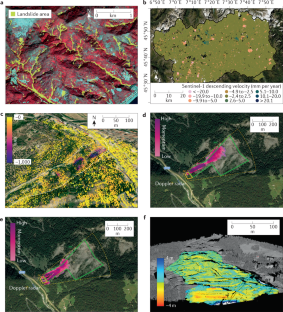
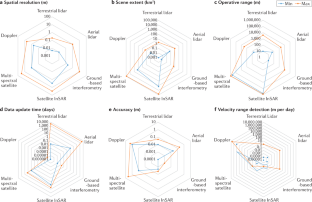
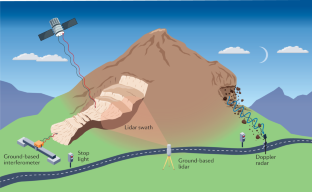
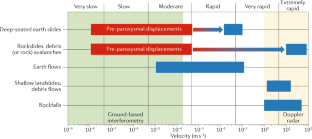
Similar content being viewed by others
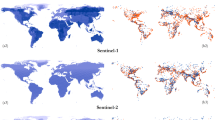
A multi-sensor approach for increased measurements of floods and their societal impacts from space
Article Open access 08 December 2023
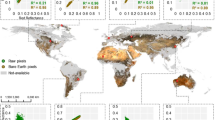
Bare Earth’s Surface Spectra as a Proxy for Soil Resource Monitoring
Article Open access 10 March 2020
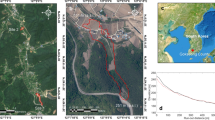
Multi-source remote sensing-based landslide investigation: the case of the August 7, 2020, Gokseong landslide in South Korea
Article Open access 27 May 2024
References
- Bennett, G. L., Miller, S. R., Roering, J. J. & Schmidt, D. A. Landslides, threshold slopes, and the survival of relict terrain in the wake of the Mendocino Triple Junction. Geology44, 363–366 (2016). ArticleGoogle Scholar
- Moreiras, S. M. Climatic effect of ENSO associated with landslide occurrence in the Central Andes, Mendoza Province, Argentina. Landslides2, 53–59 (2005). ArticleGoogle Scholar
- Petley, D. N. et al. Trends in landslide occurrence in Nepal. Nat. Hazards43, 23–44 (2007). ArticleGoogle Scholar
- Froude, M. J. & Petley, D. N. Global fatal landslide occurrence from 2004 to 2016. Nat. Hazards Earth Syst. Sci.18, 2161–2181 (2018). ArticleGoogle Scholar
- Patton, A. I., Rathburn, S. L. & Capps, D. M. Landslide response to climate change in permafrost regions. Geomorphology340, 116–128 (2019). ArticleGoogle Scholar
- Mantovani, F., Soeters, R. & Van Westen, C. J. Remote sensing techniques for landslide studies and hazard zonation in Europe. Geomorphology15, 213–225 (1996). ArticleGoogle Scholar
- Metternicht, G., Hurni, L. & Gogu, R. Remote sensing of landslides: an analysis of the potential contribution to geo-spatial systems for hazard assessment in mountainous environments. Remote Sens. Environ.98, 284–303 (2005). ArticleGoogle Scholar
- Delacourt, C. et al. Remote-sensing techniques for analysing landslide kinematics: a review. Bull. Soc. Géol. Fr.178, 89–100 (2007). ArticleGoogle Scholar
- Crosetto, M., Monserrat, O., Cuevas-González, M., Devanthéry, N. & Crippa, B. Persistent scatterer interferometry: a review. ISPRS J. Photogramm. Remote Sens.115, 78–89 (2016). ArticleGoogle Scholar
- Mondini, A. C. et al. Landslide failures detection and mapping using synthetic aperture radar: past, present and future. Earth Sci. Rev.216, 103574 (2021). ArticleGoogle Scholar
- Casagli, N. et al. Spaceborne, UAV and ground-based remote sensing techniques for landslide mapping, monitoring and early warning. Geoenviron. Disasters4, 9 (2017). ArticleGoogle Scholar
- Lillesand, T., Kiefer, R. W. & Chipman, J. Remote Sensing and Image Interpretation (John Wiley & Sons, 2014).
- Jaboyedoff, M. et al. Use of LIDAR in landslide investigations: a review. Nat. Hazards61, 5–28 (2012). ArticleGoogle Scholar
- Salvini, R., Francioni, M., Riccucci, S., Bonciani, F. & Callegari, I. Photogrammetry and laser scanning for analyzing slope stability and rock fall runout along the Domodossola–Iselle railway, the Italian Alps. Geomorphology185, 110–122 (2013). ArticleGoogle Scholar
- Rosi, A. et al. The new landslide inventory of Tuscany (Italy) updated with PS-InSAR: geomorphological features and landslide distribution. Landslides15, 5–19 (2018). ArticleGoogle Scholar
- Lombardi, L. et al. The Calatabiano landslide (southern Italy): preliminary GB-InSAR monitoring data and remote 3D mapping. Landslides14, 685–696 (2017). ArticleGoogle Scholar
- Ferrigno, F., Gigli, G., Fanti, R., Intrieri, E. & Casagli, N. GB-InSAR monitoring and observational method for landslide emergency management: the Montaguto earthflow (AV, Italy). Nat. Hazards Earth Syst. Sci.17, 845–860 (2017). ArticleGoogle Scholar
- Intrieri, E. et al. Big data managing in a landslide early warning system: experience from a ground-based interferometric radar application. Nat. Hazards Earth Syst. Sci.17, 1713–1723 (2017). ArticleGoogle Scholar
- MacDonald, H. C. & Grubbs, R. S. NASA Lyndon B. Johnson Space Center NASA Earth Resources Survey Symposium Vol. 1-B (NASA, 1975).
- Zhao, C. & Lu, Z. Remote sensing of landslides: a review. Remote Sens.10, 279 (2018). ArticleGoogle Scholar
- Martha, T. R., Kerle, N., Van Westen, C. J., Jetten, V. & Kumar, K. V. Object-oriented analysis of multi-temporal panchromatic images for creation of historical landslide inventories. ISPRS J. Photogramm. Remote Sens.67, 105–119 (2011). ArticleGoogle Scholar
- Hölbling, D. et al. Comparing manual and semi-automated landslide mapping based on optical satellite images from different sensors. Geosciences7, 37 (2017). ArticleGoogle Scholar
- Solari, L. et al. Review of satellite interferometry for landslide detection in Italy. Remote Sens.12, 1351 (2020). ArticleGoogle Scholar
- Guzzetti, F. et al. Landslide inventory maps: new tools for an old problem. Earth Sci. Rev.112, 42–66 (2012). ArticleGoogle Scholar
- Scaioni, M., Longoni, L., Melillo, V. & Papini, M. Remote sensing for landslide investigations: an overview of recent achievements and perspectives. Remote Sens.6, 9600–9652 (2014). ArticleGoogle Scholar
- Tofani, V., Segoni, S., Agostini, A., Catani, F. & Casagli, N. Technical note: use of remote sensing for landslide studies in Europe. Nat. Hazards Earth Syst. Sci.13, 299–309 (2013). ArticleGoogle Scholar
- Savvaidis, P. D. Existing landslide monitoring systems and techniques. In From Stars to Earth and Culture 242–258 (Academia, 2003).
- Ose, K., Corpetti, T. & Demagistri, L. in Optical Remote Sensing of Land Surface 57–124 (Elsevier, 2016).
- Li, J. & Roy, D. P. A global analysis of Sentinel-2A, Sentinel-2B and Landsat-8 data revisit intervals and implications for terrestrial monitoring. Remote. Sens.9, 902 (2017). ArticleGoogle Scholar
- Li, J. & Chen, B. Global revisit interval analysis of Landsat-8-9 and Sentinel-2A-2B data for terrestrial monitoring. Sensors20, 6631 (2020). ArticleGoogle Scholar
- Jacobsen, K. Characteristics of very high resolution optical satellites for topographic mapping (isprs, 2011); https://www.int-arch-photogramm-remote-sens-spatial-inf-sci.net/XXXVIII-4-W19/137/2011/.
- Li, S., Kang, X., Fang, L., Hu, J. & Yin, H. Pixel-level image fusion: a survey of the state of the art. Inf. Fusion33, 100–112 (2017). ArticleGoogle Scholar
- Santurri, L. et al. Assessment of very high resolution satellite data fusion techniques for landslide recognition. In ISPRS TC VII Symposium– 100 Years Vienna, Austria (eds Wagner, W. & Székely, B.) 5–7 (ISPRS, 2010).
- Curlander, J. C. & McDonough, R. N. Synthetic Aperture Radar Vol. 11 (Wiley, 1991).
- Wasowski, J. & Bovenga, F. Investigating landslides and unstable slopes with satellite multi temporal interferometry: current issues and future perspectives. Eng. Geol.174, 103–138 (2014). ArticleGoogle Scholar
- Bamler, R. & Hartl, P. Synthetic aperture radar interferometry. Inverse Probl.14, R1 (1998). ArticleGoogle Scholar
- Gabriel, A. K., Goldstein, R. M. & Zebker, H. A. Mapping small elevation changes over large areas: differential radar interferometry. J. Geophys. Res. Solid Earth94, 9183–9191 (1989). ArticleGoogle Scholar
- Massonnet, D. & Feigl, K. L. Discrimination of geophysical phenomena in satellite radar interferograms. Geophys. Res. Lett.22, 1537–1540 (1995). ArticleGoogle Scholar
- Zebker, H. A. & Villasenor, J. Decorrelation in interferometric radar echoes. IEEE Trans. Geosci. Remote Sens.30, 950–959 (1992). ArticleGoogle Scholar
- Ferretti, A., Prati, C. & Rocca, F. Permanent scatterers in SAR interferometry. IEEE Trans. Geosci. Remote Sens.39, 8–20 (2001). ArticleGoogle Scholar
- Berardino, P., Fornaro, G., Lanari, R. & Sansosti, E. A new algorithm for surface deformation monitoring based on small baseline differential SAR interferograms. IEEE Trans. Geosci. Remote Sens.40, 2375–2383 (2002). ArticleGoogle Scholar
- Conforti, M., Pascale, S., Pepe, M., Sdao, F. & Sole, A. Denudation processes and landforms map of the Camastra River catchment (Basilicata–South Italy). J. Maps9, 444–455 (2013). ArticleGoogle Scholar
- Zhou, X., Chang, N.-B. & Li, S. Applications of SAR interferometry in earth and environmental science research. Sensors9, 1876–1912 (2009). ArticleGoogle Scholar
- Colesanti, C., Ferretti, A., Locatelli, R., Novali, F. & Savio, G. In 2003 IEEE International Geoscience and Remote Sensing Symposium Proceedings 1193–1195 (IEEE, 2003).
- Michel, R. M., Avouac, J. P. & Taboury, J. Measuring ground displacements from SAR amplitude images: application to the Landers earthquake. Geophys. Res. Lett.26, 875–878 (1999). ArticleGoogle Scholar
- Strozzi, T., Luckman, A., Murray, T., Wegmuller, U. & Werner, C. L. Glacier motion estimation using SAR offset-tracking procedures. IEEE Trans. Geosci. Remote Sens.40, 2384–2391 (2002). ArticleGoogle Scholar
- De Zan, F. Accuracy of incoherent speckle tracking for circular Gaussian signals. IEEE Geosci. Remote Sens. Lett.11, 264–267 (2014). ArticleGoogle Scholar
- Reeves, B., Noon, D. A., Stickley, G. F. & Longstaff, D. Slope stability radar for monitoring mine walls. In Proc.Subsurface and Surface Sensing Technologies and Applications III Vol. (ed. Nguyen, C.) 57–67 (SPIE, 2001).
- Tarchi, D. et al. SAR interferometry for structural changes detection: A demonstration test on a dam. In IEEE 1999 International Geoscience and Remote Sensing Symposium 1522–1524 (IEEE, 1999).
- Atzeni, C. et al. Ground-based radar interferometry for landslide monitoring and control. In Proc. ISSMGE Field Workshop on Landslides and Natural/Cultural Heritage Trabzon (Turkey) 195–209 (ISSMGE, 2001).
- Dick, G. J., Eberhardt, E., Cabrejo-Liévano, A. G., Stead, D. & Rose, N. D. Development of an early-warning time-of-failure analysis methodology for open-pit mine slopes utilizing ground-based slope stability radar monitoring data. Can. Geotech. J.52, 515–529 (2015). ArticleGoogle Scholar
- Carlà, T., Farina, P., Intrieri, E., Ketizmen, H. & Casagli, N. Integration of ground-based radar and satellite InSAR data for the analysis of an unexpected slope failure in an open-pit mine. Eng. Geol.235, 39–52 (2018). ArticleGoogle Scholar
- Di Traglia, F. et al. Ground-based InSAR reveals conduit pressurization pulses at Stromboli volcano. Terra Nova25, 192–198 (2013). ArticleGoogle Scholar
- Del Ventisette, C. et al. Using ground based radar interferometry during emergency: the case of the A3 motorway (Calabria Region, Italy) threatened by a landslide. Nat. Hazards Earth Syst. Sci.11, 2483–2495 (2011). ArticleGoogle Scholar
- Gubler, H. Five years experience with avalanche-, mudflow-, and rockfall-alarm systems in Switzerland. In Proc. International Snow Science Workshop 1–9 (ISSW, 2000).
- Meier, L., Jacquemart, M., Blattmann, B. & Arnold, B. Real-time avalanche detection with long-range, wide-angle radars for road safety in Zermatt, Switzerland. In Proc. International Snow Science Workshop 304–308 (ISSW, 2016).
- Cui, P., Guo, X., Yan, Y., Li, Y. & Ge, Y. Real-time observation of an active debris flow watershed in the Wenchuan Earthquake area. Geomorphology321, 153–166 (2018). ArticleGoogle Scholar
- Mikoš, M. & Huebl, J. Practice guidelines on monitoring and warning technology for debris flows: TXT-tool 2.386-1.2. Landslide Dyn. ISDR-ICL Landslide Interact. Teach. Tools1, 567–585 (2018). Google Scholar
- Meier, L., Jacquemart, M., Wahlen, S. & Blattmann, B. Real-time rockfall detection with doppler radars. In Proc. 6th Interdisciplinary Workshop on Rockfall Protection 1–4 (CIMNE, 2017).
- Michelini, A. et al. A new radar-based system for detecting and tracking rockfall in open pit mines. In Proc. 2020 International Symposium on Slope Stability in Open Pit Mining and Civil Engineering 1183–1192 (Australian Centre for Geomechanics, 2020).
- Wahlen, S. et al. Real-time rockfall detection system with automatic road closure and reopening using Doppler radar technology at the Ruinon Landslide, Italy. EGU General Assembly 2021https://doi.org/10.5194/egusphere-egu21-14818 (2021).
- Viviani, F., Michelini, A. & Mayer, L. RockSpot: an Interferometric Doppler Radar for Rockfall/Avalanche Detection and Tracking. In 2020 IEEE Radar Conference (RadarConf20) 1–5 (IEEE, 2020).
- Mallet, C. M. & Bretar, F. D. R. Full-waveform topographic lidar: state-of-the-art. ISPRS J. Photogramm. Remote Sens.64, 1–16 (2009). ArticleGoogle Scholar
- Brunsden, D. Mass movement: the research frontier and beyond: a geomorphological approach. Geomorphology7, 85–128 (1993). ArticleGoogle Scholar
- Mondini, A. et al. Semi-automatic recognition and mapping of rainfall induced shallow landslides using optical satellite images. Remote Sens. Environ.115, 1743–1757 (2011). ArticleGoogle Scholar
- Achache, J., Fruneau, B. & Delacourt, C. Applicability of SAR interferometry for monitoring of landslides. ERS Appl.383, 165 (1996). Google Scholar
- Fruneau, B. N. D., Achache, J. & Delacourt, C. Observation and modelling of the Saint-Etienne-de-Tinée landslide using SAR interferometry. Tectonophysics265, 181–190 (1996). ArticleGoogle Scholar
- Kimura, H. & Yamaguchi, Y. Detection of landslide areas using satellite radar interferometry. Photogramm. Eng. Remote Sens.66, 337–344 (2000). Google Scholar
- Berardino, P. et al. Use of differential SAR interferometry in monitoring and modelling large slope instability at Maratea (Basilicata, Italy). Eng. Geol.68, 31–51 (2003). ArticleGoogle Scholar
- Rott, H., Scheuchl, B., Siegel, A. & Grasemann, B. Monitoring very slow slope movements by means of SAR interferometry: a case study from a mass waste above a reservoir in the Ötztal Alps, Austria. Geophys. Res. Lett.26, 1629–1632 (1999). ArticleGoogle Scholar
- Schlögel, R., Doubre, C., Malet, J.-P. & Masson, F. Landslide deformation monitoring with ALOS/PALSAR imagery: a D-InSAR geomorphological interpretation method. Geomorphology231, 314–330 (2015). ArticleGoogle Scholar
- Bekaert, D. P. S., Handwerger, A. L., Agram, P. & Kirschbaum, D. B. InSAR-based detection method for mapping and monitoring slow-moving landslides in remote regions with steep and mountainous terrain: an application to Nepal. Remote Sens. Environ.249, 111983 (2020). ArticleGoogle Scholar
- Singhroy, V., Alasset, P.-J., Couture, R. & Poncos, V. InSAR monitoring of landslides on permafrost terrain in Canada. In 2007 IEEE International Geoscience and Remote Sensing Symposium 2451–2454 (IEEE, 2007).
- Hao, J. et al. Investigation of a small landslide in the Qinghai-Tibet Plateau by InSAR and absolute deformation model. Remote Sens.11, 2126 (2019). ArticleGoogle Scholar
- Yao, T. et al. Recent third pole’s rapid warming accompanies cryospheric melt and water cycle intensification and interactions between monsoon and environment: multidisciplinary approach with observations, modeling, and analysis. Bull. Am. Meteorol. Soc.100, 423–444 (2019). ArticleGoogle Scholar
- Cui, P. & Jia, Y. Mountain hazards in the Tibetan Plateau: research status and prospects. Natl Sci. Rev.2, 397–399 (2015). ArticleGoogle Scholar
- Di Martire, D. et al. A nation-wide system for landslide mapping and risk management in Italy: the second Not-ordinary Plan of Environmental Remote Sensing. Int. J. Appl. Earth Obs. Geoinf.63, 143–157 (2017). Google Scholar
- Meisina, C. et al. Geological interpretation of PSInSAR data at regional scale. Sensors8, 7469–7492 (2008). ArticleGoogle Scholar
- Zhang, Y. et al. Detection of geohazards in the Bailong River Basin using synthetic aperture radar interferometry. Landslides13, 1273–1284 (2016). ArticleGoogle Scholar
- Lauknes, T. et al. Detailed rockslide mapping in northern Norway with small baseline and persistent scatterer interferometric SAR time series methods. Remote Sens. Environ.114, 2097–2109 (2010). ArticleGoogle Scholar
- Ciampalini, A. et al. Analysis of building deformation in landslide area using multisensor PSInSAR™ technique. Int. J. Appl. Earth Obs. Geoinf.33, 166–180 (2014). Google Scholar
- Raspini, F. et al. The contribution of satellite SAR-derived displacement measurements in landslide risk management practices. Nat. Hazards86, 327–351 (2017). ArticleGoogle Scholar
- Cigna, F., Bianchini, S. & Casagli, N. How to assess landslide activity and intensity with persistent scatterer interferometry (PSI): the PSI-based matrix approach. Landslides10, 267–283 (2013). ArticleGoogle Scholar
- Tofani, V., Raspini, F., Catani, F. & Casagli, N. Persistent scatterer interferometry (PSI) technique for landslide characterization and monitoring. Remote Sens.5, 1045–1065 (2013). ArticleGoogle Scholar
- Berti, M., Corsini, A., Franceschini, S. & Iannacone, J. Automated classification of persistent scatterers interferometry time series. Nat. Hazards Earth Syst. Sci.13, 1945–1958 (2013). ArticleGoogle Scholar
- Cruden, D. M. & Varnes, D. J. in Landslides: Investigation and MitigationSpecial Report 247 (eds Turner, A. K. & Schuster, R. L.) Ch. 3 (Transportation Research Board, National Academy of Sciences, 1996).
- Strozzi, T. et al. Survey and monitoring of landslide displacements by means of L-band satellite SAR interferometry. Landslides2, 193–201 (2005). ArticleGoogle Scholar
- Dong, J. et al. Mapping landslide surface displacements with time series SAR interferometry by combining persistent and distributed scatterers: a case study of Jiaju landslide in Danba, China. Remote Sens. Environ.205, 180–198 (2018). ArticleGoogle Scholar
- Cignetti, M. et al. Taking advantage of the ESA G-pod service to study ground deformation processes in high mountain areas: a Valle d’Aosta case study, northern Italy. Remote Sens.8, 852 (2016). ArticleGoogle Scholar
- Manconi, A. et al. Brief communication: rapid mapping of landslide events: the 3 December 2013 Montescaglioso landslide, Italy. Nat. Hazards Earth Syst. Sci.14, 1835–1841 (2014). ArticleGoogle Scholar
- Raspini, F. et al. Exploitation of amplitude and phase of satellite SAR images for landslide mapping: the case of Montescaglioso (South Italy). Remote Sens.7, 14576–14596 (2015). ArticleGoogle Scholar
- Singleton, A., Li, Z., Hoey, T. & Muller, J. P. Evaluating sub-pixel offset techniques as an alternative to D-InSAR for monitoring episodic landslide movements in vegetated terrain. Remote Sens. Environ.147, 133–144 (2014). ArticleGoogle Scholar
- Jaboyedoff, M. & Derron, M.-H. in Developments in Earth Surface Processes Vol. 23 (Elsevier, 2020).
- Ardizzone, F., Cardinali, M., Galli, M., Guzzetti, F. & Reichenbach, P. Identification and mapping of recent rainfall-induced landslides using elevation data collected by airborne Lidar. Nat. Hazards Earth Syst. Sci.7, 637–650 (2007). ArticleGoogle Scholar
- Chigira, M., Tsou, C.-Y., Matsushi, Y., Hiraishi, N. & Matsuzawa, M. Topographic precursors and geological structures of deep-seated catastrophic landslides caused by Typhoon Talas. Geomorphology201, 479–493 (2013). ArticleGoogle Scholar
- Sturzenegger, M. & Stead, D. Quantifying discontinuity orientation and persistence on high mountain rock slopes and large landslides using terrestrial remote sensing techniques. Nat. Hazards Earth Syst. Sci.9, 267–287 (2009). ArticleGoogle Scholar
- Gigli, G. & Casagli, N. Semi-automatic extraction of rock mass structural data from high resolution LIDAR point clouds. Int. J. Rock Mech. Min. Sci.48, 187–198 (2011). ArticleGoogle Scholar
- Battulwar, R., Zare-Naghadehi, M., Emami, E. & Sattarvand, J. A state-of-the-art review of automated extraction of rock mass discontinuity characteristics using three-dimensional surface models. J. Rock Mech. Geotech. Eng.13, 920–936 (2021). ArticleGoogle Scholar
- Giordan, D. et al. Morphological and kinematic evolution of a large earthflow: the Montaguto landslide, southern Italy. Geomorphology187, 61–79 (2013). ArticleGoogle Scholar
- Frodella, W. et al. Synergic use of satellite and ground based remote sensing methods for monitoring the San Leo rock cliff (northern Italy). Geomorphology264, 80–94 (2016). ArticleGoogle Scholar
- Hervás, J. et al. Monitoring landslides from optical remotely sensed imagery: the case history of Tessina landslide, Italy. Geomorphology54, 63–75 (2003). ArticleGoogle Scholar
- Drusch, M. et al. Sentinel-2: ESA’s optical high-resolution mission for GMES operational services. Remote Sens. Environ.120, 25–36 (2021). ArticleGoogle Scholar
- Leprince, S., Barbot, S., Ayoub, F. & Avouac, J.-P. Automatic and precise orthorectification, coregistration, and subpixel correlation of satellite images, application to ground deformation measurements. IEEE Trans. Geosci. Remote Sens.45, 1529–1558 (2007). ArticleGoogle Scholar
- Leprince, S. B., Berthier, E., Ayoub, F. O., Delacourt, C. & Avouac, J. P. Monitoring earth surface dynamics with optical imagery. Eos Trans. Am. Geophys. Union89, 1–2 (2008). ArticleGoogle Scholar
- Delacourt, C., Allemand, P., Casson, B. & Vadon, H. Velocity field of the ‘La Clapière’ landslide measured by the correlation of aerial and QuickBird satellite images. Geophys. Res. Lett.31, 2004GL020193 (2004). ArticleGoogle Scholar
- Lacroix, P., Berthier, E. & Maquerhua, E. T. Earthquake-driven acceleration of slow-moving landslides in the Colca valley, Peru, detected from Pléiades images. Remote Sens. Environ.165, 148–158 (2015). ArticleGoogle Scholar
- Xiong, Z. et al. Pre- and post-failure spatial–temporal deformation pattern of the Baige landslide retrieved from multiple radar and optical satellite images. Eng. Geol.279, 105880 (2020). ArticleGoogle Scholar
- Yang, W. Selecting the best image pairs to measure slope deformation. Sensors20, 4721 (2020). ArticleGoogle Scholar
- Bontemps, N., Lacroix, P. & Doin, M.-P. Inversion of deformation fields time-series from optical images, and application to the long term kinematics of slow-moving landslides in Peru. Remote Sens. Environ.210, 144–158 (2018). ArticleGoogle Scholar
- Lacroix, P., Araujo, G., Hollingsworth, J. & Taipe, E. Self-entrainment motion of a slow-moving landslide inferred from Landsat-8 time series. J. Geophys. Res. Earth Surf.124, 1201–1216 (2019). ArticleGoogle Scholar
- Stumpf, A., Malet, J.-P. & Delacourt, C. Correlation of satellite image time-series for the detection and monitoring of slow-moving landslides. Remote Sens. Environ.189, 40–55 (2017). ArticleGoogle Scholar
- Stumpf, A., Malet, J. P., Allemand, P. & Ulrich, P. Surface reconstruction and landslide displacement measurements with Plèiades satellite images. ISPRS J. Photogramm. Remote Sens.95, 1–12 (2014). ArticleGoogle Scholar
- Stumpf, A., Michéa, D. & Malet, J.-P. Improved co-registration of Sentinel-2 and Landsat-8 imagery for Earth surface motion measurements. Remote Sens.10, 160 (2018). ArticleGoogle Scholar
- Cigna, F., Del Ventisette, C., Liguori, V. & Casagli, N. Advanced radar-interpretation of InSAR time series for mapping and characterization of geological processes. Nat. Hazards Earth Syst. Sci.11, 865–881 (2011). ArticleGoogle Scholar
- Cigna, F., Tapete, D. & Casagli, N. Semi-automated extraction of deviation indexes (DI) from satellite persistent scatterers time series: tests on sedimentary volcanism and tectonically-induced motions. Nonlinear Process. Geophys.19, 643–655 (2012). ArticleGoogle Scholar
- Hussain, E., Novellino, A., Jordan, C. & Bateson, L. Offline-online change detection for Sentinel-1 InSAR time series. Remote Sens.13, 1656 (2021). ArticleGoogle Scholar
- Mateos, R. M. et al. The combined use of PSInSAR and UAV photogrammetry techniques for the analysis of the kinematics of a coastal landslide affecting an urban area (SE Spain). Landslideshttps://doi.org/10.1007/s10346-016-0723-5 (2017). ArticleGoogle Scholar
- Necsoiu, M., McGinnis, R. N. & Hooper, D. M. New insights on the Salmon Falls Creek Canyon landslide complex based on geomorphological analysis and multitemporal satellite InSAR techniques. Landslides11, 1141–1153 (2014). ArticleGoogle Scholar
- Zhang, Y. et al. Investigating slow-moving landslides in the Zhouqu region of China using InSAR time series. Landslides15, 1299–1315 (2018). ArticleGoogle Scholar
- Raspini, F. et al. Persistent scatterers continuous streaming for landslide monitoring and mapping: the case of the Tuscany region (Italy). Landslides16, 2033–2044 (2019). ArticleGoogle Scholar
- Journault, J. et al. Measuring displacements of the Thompson River valley landslides, south of Ashcroft, BC, Canada, using satellite InSAR. Landslides15, 621–636 (2018). ArticleGoogle Scholar
- Confuorto, P. et al. Monitoring of remedial works performance on landslide-affected areas through ground- and satellite-based techniques. Catena178, 77–89 (2019). ArticleGoogle Scholar
- Raspini, F. et al. Continuous, semi-automatic monitoring of ground deformation using Sentinel-1 satellites. Sci. Rep.8, 7253 (2018). ArticleGoogle Scholar
- Garthwaite, M. C. On the design of radar corner reflectors for deformation monitoring in multi-frequency InSAR. Remote Sens.9, 648 (2017). ArticleGoogle Scholar
- Crosetto, M. et al. Deformation monitoring using SAR Interferometry and active and passive reflectors. Int. Arch. Photogramm. Remote Sens. Spat. Inf. Sci.43, 287–292 (2020). ArticleGoogle Scholar
- Bovenga, F., Pasquariello, G., Pellicani, R., Refice, A. & Spilotro, G. Landslide monitoring for risk mitigation by using corner reflector and satellite SAR interferometry: the large landslide of Carlantino (Italy). Catena151, 49–62 (2017). ArticleGoogle Scholar
- Ferretti, A. et al. Submillimeter accuracy of InSAR time series: experimental validation. IEEE Trans. Geosci. Remote Sens.45, 1142–1153 (2007). ArticleGoogle Scholar
- Bardi, F. et al. Monitoring the rapid-moving reactivation of Earth flows by means of GB-InSAR: the April 2013 Capriglio Landslide (northern Appennines, Italy). Remote Sens.9, 165 (2017). ArticleGoogle Scholar
- Barla, G., Antolini, F., Barla, M., Mensi, E. & Piovano, G. Monitoring of the Beauregard landslide (Aosta Valley, Italy) using advanced and conventional techniques. Eng. Geol.116, 218–235 (2010). ArticleGoogle Scholar
- Di Traglia, F. et al. Review of ten years of volcano deformations recorded by the ground-based InSAR monitoring system at Stromboli volcano: a tool to mitigate volcano flank dynamics and intense volcanic activity. Earth Sci. Rev.139, 317–335 (2014). ArticleGoogle Scholar
- Kromer, R. A. et al. Automated terrestrial laser scanning with near-real-time change detection-monitoring of the Séchilienne landslide. Earth Surf. Dyn.5, 293–310 (2017). ArticleGoogle Scholar
- Catani, F. & Segoni, S. in Treatise on Geomorphology 2nd edn, 531–545 (Elsevier, 2021).
- Intrieri, E., Carlà, T. & Gigli, G. Forecasting the time of failure of landslides at slope-scale: a literature review. Earth Sci. Rev.193, 333–349 (2019). ArticleGoogle Scholar
- Hungr, O. & Kent, A. Coal mine waste dump failures in British Columbia, Canada. Landslide News9, 26–28 (1995). Google Scholar
- Hutchinson, J. Landslide risk — to know, to foresee, to prevent. Geol. Tecnica Ambientale9, 3–24 (2001). Google Scholar
- Gigli, G., Fanti, R., Canuti, P. & Casagli, N. Integration of advanced monitoring and numerical modeling techniques for the complete risk scenario analysis of rockslides: the case of Mt. Beni (Florence, Italy). Eng. Geol.120, 48–59 (2011). ArticleGoogle Scholar
- Intrieri, E. & Gigli, G. Landslide forecasting and factors influencing predictability. Nat. Hazards Earth Syst. Sci.16, 2501–2510 (2016). ArticleGoogle Scholar
- Saito, M. Forecasting time of slope failure by tertiary creep. In Proc. 7th International Conference on Soil Mechanics and Foundation Engineering, Mexico City, Vol. 2 677–683 (Sociedad Mexicana de Mecanica, 1969).
- Fukuzono, T. A method to predict the time of slope failure caused by rainfall using the inverse number of velocity of surface displacement. Landslides22, 8–13 (1985). ArticleGoogle Scholar
- Voight, B. A method for prediction of volcanic eruptions. Nature332, 125–130 (1988). ArticleGoogle Scholar
- Kilburn, C. R. & Petley, D. N. Forecasting giant, catastrophic slope collapse: lessons from Vajont, northern Italy. Geomorphology54, 21–32 (2003). ArticleGoogle Scholar
- Intrieri, E. et al. The Maoxian landslide as seen from space: detecting precursors of failure with Sentinel-1 data. Landslides15, 123–133 (2018). ArticleGoogle Scholar
- Rose, N. D. & Hungr, O. Forecasting potential rock slope failure in open pit mines using the inverse-velocity method. Int. J. Rock Mech. Min. Sci.44, 308–320 (2007). ArticleGoogle Scholar
- Carlà, T., Farina, P., Intrieri, E., Botsialas, K. & Casagli, N. On the monitoring and early-warning of brittle slope failures in hard rock masses: examples from an open-pit mine. Eng. Geol.228, 71–81 (2017). ArticleGoogle Scholar
- Petley, D. N., Bulmer, M. H. & Murphy, W. Patterns of movement in rotational and translational landslides. Geology30, 719–722 (2002). ArticleGoogle Scholar
- Torres, R. et al. GMES Sentinel-1 mission. Remote Sens. Environ.120, 9–24 (2012). ArticleGoogle Scholar
- Dong, J. et al. Measuring precursory movements of the recent Xinmo landslide in Mao County, China with Sentinel-1 and ALOS-2 PALSAR-2 datasets. Landslides15, 135–144 (2018). ArticleGoogle Scholar
- Qi, W., Yang, W., He, X. & Xu, C. Detecting Chamoli landslide precursors in the southern Himalayas using remote sensing data. Landslides18, 3449–3456 (2021). ArticleGoogle Scholar
- Dick, G. J., Eberhardt, E., Cabrejo-Liévano, A. G., Stead, D. & Rose, N. D. Development of an early-warning time-of-failure analysis methodology for open-pit mine slopes utilizing ground-based slope stability radar monitoring data. Can. Geotech. J.52, 515–529 (2015). ArticleGoogle Scholar
- Crosetto, M. et al. The evolution of wide-area DInSAR: from regional and national services to the European Ground Motion Service. Remote Sens.12, 2043 (2020). ArticleGoogle Scholar
- Rosen, P. et al. The NASA-ISRO SAR (NISAR) mission dual-band radar instrument preliminary design. In IEEE International Geoscience and Remote Sensing Symposium (IGARSS) 3832–3835 (IEEE, 2017).
- Kristensen, L. et al. Movements, failure and climatic control of the Veslemannen rockslide, Western Norway. Landslides18, 1963–1980 (2021). ArticleGoogle Scholar
- Xu, Q., Yuan, Y., Zeng, Y. & Hack, R. Some new pre-warning criteria for creep slope failure. Sci. China Technol. Sci.54, 210–220 (2011). ArticleGoogle Scholar
- Alcántara-Ayala, I. & Oliver-Smith, A. in Identifying Emerging Issues in Disaster Risk Reduction, Migration, Climate Change and Sustainable Development 101–124 (Springer, 2017).
- Alcántara-Ayala, I. & Moreno, A. R. Landslide risk perception and communication for disaster risk management in mountain areas of developing countries: a Mexican foretaste. J. Mt. Sci.13, 2079–2093 (2016). ArticleGoogle Scholar
- Intrieri, E., Gigli, G., Casagli, N. & Nadim, F. Brief communication ‘Landslide early warning system: toolbox and general concepts’. Nat. Hazards Earth Syst. Sci.13, 85–90 (2013). ArticleGoogle Scholar
- Varnes, D. J. Landslide types and processes. Landslides Eng. Pract.24, 20–47 (1958). Google Scholar
- Zaruba, Q. & Mencl, V. Landslides and Their Control (Elsevier, 1969).
- Aleotti, P. A warning system for rainfall-induced shallow failures. Eng. Geol.73, 247–265 (2004). ArticleGoogle Scholar
- Van Asch, T. W. J., Buma, J. & Van Beek, L. P. H. A view on some hydrological triggering systems in landslides. Geomorphology30, 25–32 (1999). ArticleGoogle Scholar
- Zêzere, J. L., Trigo, R. M. & Trigo, I. F. Shallow and deep landslides induced by rainfall in the Lisbon region (Portugal): assessment of relationships with the North Atlantic Oscillation. Nat. Hazards Earth Syst. Sci.5, 331–344 (2005). ArticleGoogle Scholar
- Varnes, D. J. Slope movement types and processes. Spec. Rep.176, 11–33 (1978). Google Scholar
- Hungr, O., Leroueil, S. & Picarelli, L. The Varnes classification of landslide types, an update. Landslides11, 167–194 (2014). ArticleGoogle Scholar
- Carlà, T. et al. Rockfall forecasting and risk management along a major transportation corridor in the Alps through ground-based radar interferometry. Landslides16, 1425–1435 (2019). ArticleGoogle Scholar
Author information
Authors and Affiliations
- Department of Earth Sciences, Università degli Studi di Firenze, Florence, Italy Nicola Casagli, Emanuele Intrieri, Veronica Tofani, Giovanni Gigli & Federico Raspini
- Nicola Casagli








